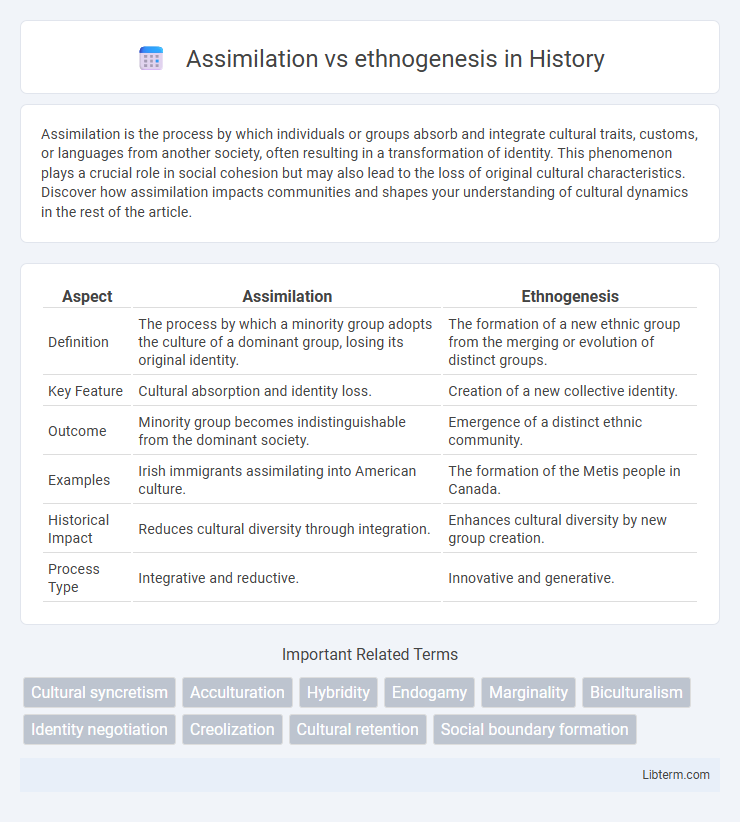Assimilation is the process by which individuals or groups absorb and integrate cultural traits, customs, or languages from another society, often resulting in a transformation of identity. This phenomenon plays a crucial role in social cohesion but may also lead to the loss of original cultural characteristics. Discover how assimilation impacts communities and shapes your understanding of cultural dynamics in the rest of the article.
Table of Comparison
| Aspect | Assimilation | Ethnogenesis |
|---|---|---|
| Definition | The process by which a minority group adopts the culture of a dominant group, losing its original identity. | The formation of a new ethnic group from the merging or evolution of distinct groups. |
| Key Feature | Cultural absorption and identity loss. | Creation of a new collective identity. |
| Outcome | Minority group becomes indistinguishable from the dominant society. | Emergence of a distinct ethnic community. |
| Examples | Irish immigrants assimilating into American culture. | The formation of the Metis people in Canada. |
| Historical Impact | Reduces cultural diversity through integration. | Enhances cultural diversity by new group creation. |
| Process Type | Integrative and reductive. | Innovative and generative. |
Introduction to Assimilation and Ethnogenesis
Assimilation refers to the process by which individuals or groups adopt the cultural traits of another, often dominant, society, leading to a reduction in cultural distinctiveness. Ethnogenesis describes the formation and development of a new ethnic group, emerging from the fusion or transformation of existing cultures and identities. Both concepts are crucial for understanding the dynamics of cultural identity, social integration, and the evolution of ethnic communities over time.
Defining Assimilation: Concepts and Processes
Assimilation involves the process by which individuals or groups adopt the cultural traits, languages, and social norms of another dominant group, often leading to the gradual loss of their original cultural identity. Key concepts include acculturation, integration, and cultural convergence, where social, economic, and political factors influence the extent and speed of assimilation. Processes such as language adoption, intermarriage, and participation in dominant societal institutions are critical mechanisms driving assimilation in multicultural environments.
Understanding Ethnogenesis: Formation of New Identities
Ethnogenesis refers to the process by which distinct ethnic groups emerge through the creation of new social identities, often resulting from the blending of existing cultures, shared experiences, and common historical narratives. Unlike assimilation, where minority groups gradually absorb the dominant culture, ethnogenesis involves deliberate identity formation, emphasizing unique traditions, languages, and symbols that differentiate the new group from others. This process plays a crucial role in the dynamic evolution of ethnic landscapes, particularly in contexts of migration, colonization, and social change.
Historical Contexts of Assimilation and Ethnogenesis
Historical contexts of assimilation often involve dominant cultures imposing language, customs, and social norms on minority groups to integrate them politically and economically. Ethnogenesis, by contrast, arises in contexts of social upheaval, migration, or colonization when new ethnic identities form through the blending or redefinition of existing groups' cultural traits. Examples include the formation of the Metis in Canada and Afro-Caribbean identities, highlighting dynamic processes of identity construction beyond forced assimilation.
Key Differences Between Assimilation and Ethnogenesis
Assimilation involves the process where a minority group's cultural traits are absorbed and replaced by those of a dominant culture, resulting in cultural homogenization. Ethnogenesis refers to the formation and development of a distinct new ethnic group, often emerging from intermixing or shared experiences, preserving unique cultural identities. Key differences include assimilation's tendency to diminish cultural diversity, while ethnogenesis contributes to the creation and recognition of diverse ethnic identities over time.
Factors Driving Assimilation in Societies
Factors driving assimilation in societies include prolonged intergroup contact, socioeconomic integration, and shared language adoption, which facilitate cultural blending and identity merging. Structural conditions such as urbanization, education systems, and political frameworks also play crucial roles in promoting assimilation by aligning minority group behaviors with dominant cultural norms. Social pressures, including discrimination or the pursuit of economic advancement, further motivate individuals to adopt majority cultural traits, accelerating the assimilation process.
Influences Leading to Ethnogenesis
Influences leading to ethnogenesis include shared languages, cultural practices, and collective memories that foster a distinct group identity. Historical events such as migration, intermarriage, trade, and conflict contribute to the blending and emergence of new ethnic groups. Unlike assimilation, which involves minority groups adopting the dominant culture, ethnogenesis emphasizes the creation of unique social and cultural identities through dynamic interactions.
Case Studies: Assimilation and Ethnogenesis in Practice
Case studies of assimilation and ethnogenesis reveal diverse outcomes in cultural identity transformation, such as the Cherokee Nation's revitalization efforts exemplifying ethnogenesis amid historical assimilation pressures. Research on immigrant communities in the United States shows varying degrees of assimilation, with some groups maintaining distinct ethnic identities while others gradually merge into the dominant culture. Comparative analysis of these case studies highlights the dynamic interplay between external social forces and internal group agency in shaping ethnic continuity and change.
Social and Cultural Impacts of Both Processes
Assimilation leads to the blending and often loss of distinct cultural identities as minority groups adopt dominant societal norms, resulting in reduced cultural diversity and weakened traditional practices. Ethnogenesis fosters the formation of new ethnic identities and cultural expressions, enhancing group solidarity and preserving unique social customs while responding to changing socio-political contexts. Both processes significantly shape social cohesion and cultural landscapes by influencing identity preservation, intergroup relations, and community resilience.
Contemporary Relevance and Future Perspectives
Contemporary relevance of assimilation lies in its impact on social integration, where minority groups adopt dominant cultural traits, influencing identity loss and multicultural dynamics. Ethnogenesis, the process of new ethnic identities forming through interactions and adaptations, highlights ongoing cultural evolution and resistance to homogenization in globalized societies. Future perspectives emphasize the balance between preserving unique ethnic identities and embracing inclusive policies that promote diversity and social cohesion amid increasing migration and digital connectivity.
Assimilation Infographic

 libterm.com
libterm.com